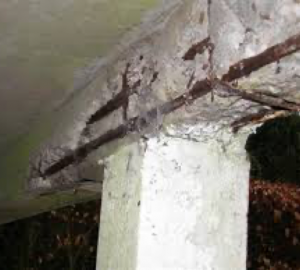Structural Concrete Repair
What is Structural Concrete?
 “Structural concrete” is the term commonly used when referring to concrete elements that provide the primary support for structures such as buildings, parking garages, bridges, etc. These structural elements are commonly seen in the form of vertical columns, horizontal beams, and elevated slabs. To achieve the necessary strength and load capacity for these elements, reinforcing steel, such as rebar, is embedded into the concrete during construction.
“Structural concrete” is the term commonly used when referring to concrete elements that provide the primary support for structures such as buildings, parking garages, bridges, etc. These structural elements are commonly seen in the form of vertical columns, horizontal beams, and elevated slabs. To achieve the necessary strength and load capacity for these elements, reinforcing steel, such as rebar, is embedded into the concrete during construction.
If structural concrete elements are exposed to excessive moisture, these can become severely compromised. This occurs when moisture migrating into the concrete comes in contact with the reinforcing steel which then begins to corrode (rust). Corrosion causes the reinforcing steel to expand placing outward pressure on the concrete element which causes cracks and/or delamination, commonly referred to as “spalling”. Once this process starts it can accelerate rapidly because moisture has an open path to the reinforcing steel. Where salts and de-icing chemicals are used on structural concrete elements, corrosion of the reinforcing steel is exacerbated.
The Repair Process
Structural concrete repair work is labor intensive and can be very expensive. Proper repairs require chipping/removing the concrete around the corroded rebar, for a minimum clearance of ½ inch around the steel. The rebar should be carefully cleaned of corrosion then treated with a rust inhibitive coating to protect it from future corrosion. Severely corroded steel can be replaced or supplemented with new steel. The repair area should then be patched with a properly selected concrete repair mortar. Larger areas can be formed and poured with the appropriate patching materials.
To protect structural concrete elements, it is crucial to prevent moisture intrusion. There are numerous waterproof coatings designed specifically for this purpose, but not all are equal, so careful selection is critical. Proper maintenance of expansion and control joints is also critical to prevent water intrusion. Conducting periodic inspections of structural concrete is good practice, and if warning signs such as cracking or spalling are noticed, getting ahead of the problem early could save thousands down the road. Ignoring these warning signs could lead to catastrophic failure, and potential collapse.